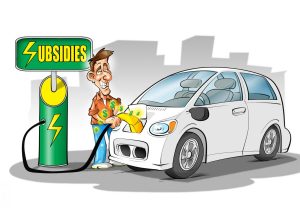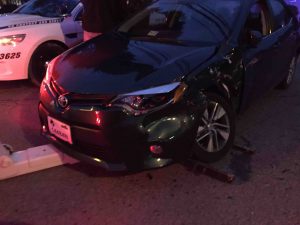Toyota just announced it would be “investing” $500 million in Uber, the ride-sharing service, to further development of “autonomous” – that is, automated – vehicles and “mobility as a service.”
The reason Toyota and several other car manufacturers are making these “investments” is for one reason only: They know they cannot continue to sell cars for very much longer because people increasingly cannot afford to own them.
For three reasons.
First, the accretion of cost due to mandates that are becoming – and arguably already are – economically unsupportable.
Adding a single catalytic converter to a car back in ’75 (the first year for them) added a couple hundred bucks, maybe, to the price of a new car – and reduced harmful emissions by double digits. Adding four cats and O2 sensors plus direct injection (and a separate port fuel-injection system to deal with the problems created by the DI system) adds probably several thousand dollars to a car vs. a throttle body (TBI) injection system for reductions in pollution you need a 400x power microscope to see.
The government is now insisting on essentially zero emissions – regardless of cost. And no matter that a car which emits almost zero emissions isn’t a threat to anyone’s health.
Cars are going to get even more expensive if the government insists they average 50-plus MPG (Trump is trying to prevent this) which would have the same effect as a general electric car mandate because adding electric cars – which don’t burn any gas – to a car company’s model lineup makes it more feasible to sell cars that do burn gas but don’t get 50-plus MPG, by improving the car company’s overall “fleet average” fuel economy figures.
Electric cars also emit no carbon dioxide – which the government now characterizes as an “emission” subject to regulation – even though it is an irrelevance as regards air quality or public health. Nonetheless, the only way to reduce C02 emissions is to build fewer IC cars – and more electric cars.
But electric cars are much to expensive for most people to buy, so they have to be given away at a net loss per car. The problem with that – for the car companies – is obvious.
Which brings us to the second reason for the desperate rush toward “mobility as a service.”
In addition to the costs imposed by government fatwa, there is the rip-tide-like effect on the cost of cars generally of a population that largely loves debt and living beyond its means combined with a mania for whatever’s New . . . with New things (mostly electronic things) becoming available literally all the time.
The problem is these things cost money – and most people haven’t got it. Most people aren’t earning more of it, that is – enough to keep pace with the increasing cost of new cars equipped with all the Newest and Latest things.
So they finance. And the problem with that – when it comes to cars – is that cars are rapidly depreciating consumer appliances. You can only finance so far. Or rather, so long. Seven – maybe eight years, being the outer limit because at that point, no matter what you started out with, it will be worth less than half its original purchase price.
There isn’t much incentive to keep making payments on a thing that is worth less than what you still owe on the balance due – with years of payments yet to make. And even less incentive to make a loan on such an item – something lenders understand very well.
Thirdly, there is the problem of the peripheral costs of car ownership. Insurance costs are skyrocketing because cars have become too complex, fragile and more disposable.
While they don’t need the regular tuning-up and other minor adjustments cars once needed, when they do need work, it is often extremely expensive – because of the complexity of the components and the specialized diagnostic equipment and highly-trained (and highly expensive) technicians needed to service them competently.
They are also easily damaged. Front and rear clips are made of plastic; hoods and fenders of extremely thin gauge metal (often, aluminum) in order to shave weight and increase mileage (to comply with government MPG fatwas) with the result being that what used to be minor fender-benders are now major accidents, in terms of repair costs – and these costs are necessarily being reflected in insurance costs. While the insurance mafia is despicable – any business that uses the government to force people to buy its services is despicable – one cannot blame them for adjusting premium costs to reflect repair costs.
Cars now have so many air bags – the average new car has at least six – that the chances of the car being declared a total loss (economically unrepairable) in the event of a relatively minor – and otherwise repairable – accident are high. It can cost several thousand dollars to replace just two air bags – and all the related interior parts destroyed when the air bags go off. This is before one adds up the cost to repair damaged body panels. Most insurance companies will write-off a car as a total loss if the estimated cost to fix it exceeds 50 percent of its retail value.
Getting to 50 percent isn’t hard when a car is say four or five years old, worth 60 percent what you paid for it – and the wreck you just had will take $10,000 to repair (a third of that cost being the cost to replace the air bags that went off).
A car that cost $35,000 when it was new – the average purchase price of a 2018 model car – is effectively worthless after just a few years or a fairly minor accident. It is a lot of money to just throw away.
These synergies – the cost of government mandates, the debt-financed upticking in the average price of cars plus the increasing peripheral costs of car ownership – are headed in an obvious direction:
Which is what “mobility as a service” amounts to. People who cannot afford to buy cars anymore will rent them instead. And not even rent the cars, per se.
They will buy rides.
There is admittedly an element of convenience – for city people, perhaps (those who aren’t city people will inevitably have to wait for their ride to appear; no more just getting in and going) and it is without doubt a way to make “transportation” more “affordable.”
But it is also a depreciation of something important.
When you own your car, you are free to take a drive wherever you like, however you like, as long you like – and at the spur of the moment, if you like. These automated ride-sharing cars will turn you into a passenger in a bus for one. You will have ceded control over your movements – when not on foot – to a collective, which will decree when and how you move.
Loss of ownership is also exactly like having to “share” your living space with other people. A community car is like a community bathroom, roommates eating your food and other such delights of the impecunious. It’s okay when you’re 21 and temporary. But when you’re 41 – and it’s permanent . . . not so much. 
“Mobility as a service” is a diminishment. It is part of the proletarianization of the American people.
It’s tragic. More so because it’s unnecessary.
If it weren’t for the government fatwas and a gadget-addled, debt-addicted populace, there would be brand-new cars most people could stroke a check for – or which only took three or four years to pay off, as was once the case – though no one remembers that anymore, either.
Just like they don’t remember what it was like to be able to ride a motorcycle without a helmet, argue with a cop without risking death and board an airplane without a prostate check.
. . .
Got a question about cars – or anything else? Click on the “ask Eric” link and send ’em in!
We depend on you to keep the wheels turning! And we are running low this month. If you like what you’ve found here, please consider supporting EPautos.
Our donate button is here.
If you prefer not to use PayPal, our mailing address is:
EPautos
721 Hummingbird Lane SE
Copper Hill, VA 24079
PS: EPautos magnets are free to those who send in $20 or more. My latest eBook is also available for your favorite price – free! Click here. If you find it useful, consider contributing a couple of bucks! 














Late response but – there’s more to it than even you’re thinking about. See, you and other people have correctly pointed out that cars make lousy investments – but even the most worn-out and dilapidated car is worth a few dollars, and any car, from a $280 beater to a brand new machine to the bluest of blue-chip collector cars, has intrinsic value for as long as it’s in one piece with the engine running and connected to the wheels, and those wheels attached somewhat solidly to the chassis, which instantly makes any car a better investment (at least by percentage of profit or loss) than a subscription to a service.
Let’s say you’re riding high, rolling in dough, so rich you can walk into a dealership, slam down a wad of hundos, and drive away in their newest, fanciest sports or luxury car. Now let’s say it’s a few years down the road and you’ve fallen on hard times – maybe the markets crashed and you took a bath, maybe you had other debts, who knows. Either way, it’s taken everything you had just to settle accounts, and now you’re struggling… but you’ve still got that car. You can continue to use it for transportation, or you can sell it and have money for a Craigslist beater plus a few months of bills.
Or maybe you’re not so rich, but you at least have enough money to buy a cheap used car off the internet and use that. It works the same way.
Now let’s say that you never did either of those things, and you’ve been leasing, renting, or ride sharing. Now, struggling to pay your bills, you can no longer afford to subscribe. Now, car goes bye-bye and you get nothing. All that money has just been disappearing into a black hole and you’re never going to get a cent of it back. You lose. Too bad, so sad. Your “mobility” will be gone just as if you’d never had it.
Well-said, Chuck.
A paid-for and functionally viable car is fungible. It is a store of wealth and of intrinsic value as transportation. I may have to elaborate this at length. Thanks for the inspiration!
It’s a really good point that Chuck makes. The less income you have, the fewer monthly payments that you have the better.
They love to tell you it’s only $5 a month or $10 or $20. But many are for a lot more then that $90, $120, and that doesn’t include what most pay on their car. All those little things add up to real money.
Money you don’t have when your income drops down to zero or a very small amount. Watch your saving dry up fast. Really fast. Since my income has been crap the last decade I have dumped as many as i can, and plan on not letting them return if my situation improves.
Minimum wage people really can’t afford monthly payments at all to be honest. But they end up with them about the most.
Hope you do write about this.
Hi Eric. This got me thinking about a commercial I heard recently about a new app. It is called “Fair” and it is apparently temporary “ownership” of a car. The way it appears to work is a month-to-month lease. They advertise that you “can return the car at any time” and “pick a new one.” It sounds like a bad deal to me.
Yes, everyone, I used the word “app”. Please don’t let that detract from the content of my comment.
“Mobility As A Service”? That sounds like a service for the disabled.
Then again, thanks to those little glowing magic rectangles, most people living in “first-world” countries have essentially become just that: disabled.
Hi BlueGrey,
An irony of this whole business is that mobility is the opposite of what’s being provided. Mobility means being able to just jump in my car and go somewhere right not, as I please. How does having to wait for your ride-share to show up and then meatsacking it to wherever you’re going on the schedule of the ride-sharing/automated car make you more “mobile.”
“How does having to wait for your ride-share to show up and then meatsacking it to wherever you’re going on the schedule of the ride-sharing/automated car make you more “mobile.”
See, that’s the idea; it doesn’t. But of course the “sheep” not only don’t give a damn, but are in fact, begging to be herded to the “slaughterhouse”. As long as they get to take “selfies”, play Candy Crush, or partake in some other God-forsaken social media activity along the way, they’re happy.
Hi Bluegray,
Yup. I ought to go to Mexico, while there is still time, and find myself a nice senorita and forget all of this.
Sigh.
But then, my stubbornness and middle-aged ossification kick in…
eric, I was your age when I went to Mexico and stayed for a while. I was pleasantly surprised to find women, even very young ones, are smart and not fickle, having respect for older men since they can see we’ve lived that long by not being stupid. There’s not a real age discrepancy thing going there. My cousin and I toted a couple gals 30 years younger than us around and had a lot of fun and so did they.
There was an 18 year old, incredibly smart and well-educated who would have taken the chance of getting smuggled back with me and she said so. I later helped her family get over the border.
They were very smart and extremely English literate. I wanted to go fishing and both her and her younger sister had no qualms at all about taking a fishing trip in the mountains with 50+ age men. They really got educations there and a lot came from the attitude of their parents. BTW, schools there had armed guards. They made sure the kids made it from home to school and back, even having armed guards on the bus. You’d have to be very lucky to get into any school there I saw armed or otherwise.
Going to the bank….and the liquor store, there was always one guy outside protecting customers with an AR. I felt very safe there and everyone with a gun was privately employed….except maybe for the schools but a lot of the schools were private.
The only people I had trouble with were the young gang members. Of course everyone had a problem with them.
I would go in a minute if I could find a decent job there. I viscerally hate this culture more and more. I have really not been a fan my entire life. All this shit started in the 50s with the stupid youth oriented culture. Sockhops and soda fountains first. Then came the hippies and then the buzz cuts. Ugh. Each culutre was happy to give up freedoms we once had but that trend really started accelerating in the 1960s and 1970s. Re: 70’s think 55.
Asia is a good option too but you will always be an outsider.
Instead of Mexico, try further south. Like Argentina (San Rafael, Bariloche) or Chile (Santiago, Concepción). Uruguay is another very good option.
Bariloche is like a small Bavarian village on a huge lake. Full of Europeans too. It is easier to blend with the locals, but more expensive.
The Google car has covered most of South America. You can click on most roads and see what the area is like regarding roads and the general condition of an area. Watch the dates though. Many images are 5+ years old.
Just poking around on some real estate sites and found several grape farms with house & 5-60 acres, near San Rafael for $30-90kUS. Crap houses generally but with the basics for living. The grapes from these areas are very good and sought after.
Also beware the different crime levels. The Google car is good for this. If an area is walled off like the Green Zone and has bars on the windows, probably some crime issues but will also be very cheap.
Just remember that the Argentine economy is tanked and imports are very expensive. Fortunately that also means the government has little to spend on oppression and your US dollar will go far.
There are companies that specialize in shipping all your stuff to South America. Basically you load a container, send it ahead and fly down to meet it in a week or two.
My take on all this crazy stuff regulated into our cars has more to with limiting competition than safety or emissions. Granted this stuff sells to the average consumer. It’s pretty obvious to me that when our Fed gov. (epa) changes an emission standard a fraction here and there, it has much more to do with limiting newer or lesser manufacturers from being able to compete with the existing large companies.
I can’t prove it, but when our epa drastically upped the diesel emission standards around 10 years ago, it was about the same time that asian diesels had finally caught up to our old standards and were about to be able to sell diesels to the West at a fraction of the cost of the big boys. A light diesel pick-up is now 60K plus.
An example in my business, is we use diesel engines for large generators, portable construction equip., etc… and these new regs (tier 4 standard) were delayed for these manufacturers (hundreds in the usa) because they sell far fewer numbers than trucks. This year was the last year for the Tier 3 standard and 40K equipment now has become 50K equipment, with much higher maintenance requirements. So contractors and users of this equipment just has to pass on the cost to the masses. We keep paying more and more, it’s getting ridiculous.’
One of my common taking points to friends when we ‘sit around the campfire’ is “what was wrong with a ’97 Chevy 1500?” If they still made the same truck, many other manufacturers could have copied it by now and you could get one for $20K today new, with parts avail. really cheap.
Hi Chris,
Exactly so. The only point I take issue with is “our” EPA. It is their EPA. The people/interests which control the government. Which isn’t us!
And you’re right. There is nothing wrong with a circa ’97 1500. In fact, trucks from that era are in my opinion the apotheosis of sound design. Their emissions were almost nil in any meaningful sense and they were exceptionally durable and still mostly DIY-repairable. Such a truck could be made today for about $20k today, as you say. Imagine the positive effect on the economy, on people’s financial well-being.
But that isn’t the object of the exercise. The object of the exercise is to enslave people with debt and to drive people out of their vehicles, ultimately.
Thanks for the reply Eric. Not many of my peers care. It is refreshing that someone agrees that this is going on. It really is a scam of epic proportions. So are a lot of other things.
One of your other articles about that Roxor jeep has me intrigued. It would be legal in some states to drive it with some restrictions. I’m wondering if they start popping up in numbers in small towns that local police/sheriffs dept. will just start looking the other way to drive ‘around’ those restrictions. I have some hope.
You bet, Chris!
And, me too. If a critical mass simply began to ignore all these obnoxious laws, progress back toward sanity and liberty would be possible. Those who disagree ought to consider what’s happened with pot. It has become de facto (and even de jure) legal in most parts of the country in part because of widespread mocking and general evasion/ignoring/contempt for the laws prohibiting its use/possession and so on.
Eric, Christ, re: Pot. Pot and other drugs are becoming legal all over the world almost simultaneously, and it isn’t due to ignoring the law. It’s because the corporate mindset as changed. They know that not only can they make more money growing, and distributing the stuff, they can regulate the hell out of it, and still keep their prisons full of those who violate those regulations; a win/win. They also know that a country doped up on grass is going to be much easier to manipulate just like the slaves who used to pick cotton in the good ol’ days before abolition.
The backlog in the courts today is ridiculous. You must pay your fine up front, but your day in court could be at least three months off, and more often than not it won’t be for years. They know most will just give up on the idea just like people in Bolivia, Venezuela, Iran, etc.
We also did it with the 55 mph speed limit. Although the situation isn’t perfect by a longshot, we were able to dial the speed limits back up to a marginally sane level. I vividly remember the chorous of people who told me I was crazy and that we would “never” get rid of it.
Don’t the 1996 and newer Chevy pickups have “Vortec” engines with MPI and OBDII ???
1988-1995 with TBI would be better!
You should also look at an app called “Fair”. Yes, I used the word “app”, don’t let that distract from the actual point here.
You can “own” a car for as little as a month or as many months in a row as you wish. You can return it at any time, and can pick out a new one. The commercials actually try to make this sound like a good thing.
It’s basically a variable term lease. That is the next stage of car “ownership.”
Just wait until the clover control freak majority is now using a service to get around. They will start banning things like garages, car ownership, having a car in your driveway, etc. Democracy they say. Tyranny of the majority I say. A manufactured majority to vote in the desires of the very few.
I can’t really relate to much of this because I don’t buy new cars, I don’t borrow money to buy crap I can’t afford, and when it comes to repairs I go to the local Pick-n-Pull. Some guy peeled my driver’s side door back while pulling his boat trailer up a launch ramp. He almost tore my leg off in the process, but after we exchanged information, I found out later he had changed insurance carriers. I had already sent him three estimates, the cheapest being $1,200.00 which I doubted he was going to pay. So I picked up a salvaged door for $65.00, and a few weeks later, he actually did send the check. I only paid $1,400.00 for the van ten years earlier so after a few more years I just parked it, and use it for extra storage space now. It’s cheaper than building or buying a storage shed, and I probably couldn’t get enough for the van to cover the cost of the storage shed either.
There are quite a few videos on youtube showing people painting their vehicles with Rust 0 leum, and Bondo is of a superior quality than it used to be 30 years ago. A friend of mine picked up a wrecked Camaro that had the entire right side destroyed. He was able to get the door pounded out enough to get a new window in and then proceeded to put about ten gallons of Bondo over the whole thing. After paint, it looked as good as new. In Mexico, and some of the border towns, they will fill large dents with adobe mud and then top of the last half inch to contour with Bondo, then paint. The stuff actually lasts quite a while before it cracks.
Again, this is not a problem for those who have money to afford all of these things that are most likely going to become major problems for those who are strapped for cash. Look to so-called third world countries where these regulations don’t exist and the “rich” down there are driving the same cars you used to drive, e.g. sans smog crap, air bags, fuel mileage fatwas etc. More often than not, these aren’t problems until one starts to feel it in their wallet, or when they see how much better off their wallet is outside these regulatory scams.
“Bondo” brand is still crap body filler. However there are various quality body fillers out there.
Large dents can be pulled or pushed out reasonably well. Even novice can do it well it enough to only have thin coat of filler. Not bothering to get the dent out at all is just silly. Wast more time time and material filling it.
Reminds me of a 68 Dodge Dart I had many many years ago. Ran great but every body panel was a different color. I got a couple cans of high gloss rust oleum, a real high quality camel hair brush, and waited for a really hot sunny day. Laid it on real thick. The sun baked the brush marks right out, and I was quite surprised, the car actually looked pretty damn good.
Who cares about dents as long as they are not impinging on anything important?
Interesting point made by Eric and others here about urban vs. rural drivers. The Uber service and others for the most part isn’t economically viable without a certain density of customers. And as suburbs expand those densities drop. So shared “services” like rides are much more costly to operate.
Farmers, etc. could of course use fully automated vehicles (when they finally become “safe”) but only if the non vehicle controls (i.e. on roadways, overpasses, shoulders, roadway cameras, etc.) are also put on every two track and cow path in the boondocks. Or private roads on ranches, farms and forest land.
At some point AI might render these auxiliary control devices unnecessary but that won’t be for quite a while. Initially the road surfaces/underlay will do much of the guidance. However “congestion” isn’t a major problem in non urban areas. And that is one of the touted benefits (reducing vehicle crawl) for automated driving. Then there is the matter of large semis or cargo vans and trucks which need to do a great deal of close-in vehicle turning, backing, lifting, wedging and waiting. The inputs and directions for a robotic semi truck maneuvering in a warehouse will be something to behold.
Human controlled vehicles will be with us until people no longer want those controls. That is probably never. The main “tool” for automated driving will be urban restrictions on roadway usage to control traffic flow. Plus, insurers may charge more or cover damages less if humans are found a “fault.” But I don’t think the robots are going to win this battle easily, if ever. Not in my lifetime anyway.
Great read as usual.
The ride-share concept is ideal for me. I live in an urban area, use a wheelchair. I ditched my car rather than buy a new one.
After crunching numbers, it came out as less expensive and more convenient short term and long term to opt for ride-share services. No worries about stressing out in traffic, no worries about finding an accessible parking space, no worries about my car sitting and depreciating by the second.
If I want to go on my own somewhere outside the city, I can usually find a great deal on a weekend car rental.
However, I’m not sure how convenient and cost effective ride-share would be if I lived in the suburbs or the country.
Gary, I’m seeing more and more people doing the same thing you are and wondering why they didn’t do it sooner. Around here people motorize bicycles with 50 hp 2 stroke engines (some are as much as 150 hp), or electric motors. They go everywhere in these things and LOVE them. The chances that they will need some large truck to haul anything are so seldom, when the time comes they just rent it for a day or two and the savings is night and day. I’ve even seen some people turning electric wheelchairs into speed demons. I saw one actually pop a wheelie going across a cross walk.
People do not want to be free, they want to be entertained. They will take mindless stimulus over Liberty all day everyday.
Fools cannot do Freedom.
Well stated. It takes INDEPENDENT thinking to appreciate liberty!
“People do not want to be free, they want to be entertained. They will take mindless stimulus over Liberty all day everyday.”
Amen to that! This is especially true with my generation (millennials). If it doesn’t involve social media, then they don’t want it.
If you want proof of how stupid and malleable most Americans are, witness the nonstop blubber-a-thon for the murderous creep John McCain.
Hi Roland,
Amen – did you catch my obit? https://www.ericpetersautos.com/2018/08/26/he-is-gone-and-i-am-glad/
I have now. Excellent!
Glad you liked it, Roland! I felt better after writing it…
And one more cost being foisted upon those who would buy a new car: GAP Insurance.
This allows you to pay for the privilege of not being able to pay in full with cash the cost of a new car. In addition to the interest on the loan for the car. A way to “protect” you in case you get into a vehicle termination event (a totaled car) and you owe more than the car is worth.
Before new cars got so expensive, and took so long to pay off, this product didn’t even exist. Now, I’ll bet almost all new cars have this add-on for the “owner” to pay as he (or she) goes.
Hi Travis,
Indeed; I should have mentioned that… so, hat tip for mentioning it!
“… they don’t remember what it was like to be able to ride a motorcycle without a helmet, argue with a cop without risking death and board an airplane without a prostate check.”
Terse and to the point. I’m adding this to my list of quotes. Thanks Erik.
My pleasure, Larry!
I drive a 2005 Honda Civic whose body has seen better days. I could get maybe $2000 for it if I advertised it on Craigslist.
Six months ago, I backed into a tree and wiped out a rear tail light and put a dent in a rear panel. Estimated cost of repairs at the body shop = $1500. But wait. There was also some damage to the connection between the rear panel and the rear bumper. “Sorry, fella, your car’s totaled.”
I got a replacement tail light on ebay for $40 and me and a friend banged the dent out and re-attached the rear panel and bumper with pop rivets enough for the car to pass inspection. Ipainted the scraps with paint that doesn’t quite match but who cares.
Total cost = $63.50. Of course, R&M costs will exceed the car’s value. It leaks oil and will eventually need a new head gasket, a brake job and a timing belt but, for now, it goes and takes me with it. Don’t tell the Feds!
Hi Imbroglio,
At some point – probably soon – I expect the government will make such “unapproved” repairs illegal. For saaaaaaaaaaaaaaaaaaaaaaaaaaaaaaaaaaaaaaafety, of course.
Not to worry Eric, “sharing your living space with other people” is on the agenda as well. They want everyone in the cities or at least within the inner suburbs.
At this point it may be faster to list reasons not to GTFO of this country.
Hi Fred,
It probably is only a matter time before someone begins to warble about how “unfair” it is that some people have a house all to themselves, with rooms they don’t really need. Expropriation!
Just as happened in Soviet Russia, after the Communists took power.
Also in Venezuela soon after Chavez took power (which is why the middle class fled to the US and Spain ~15 years ago). Also in Europe now, so the Muslim rapefugees have a place to sleep.
Hi Zenit,
Yup. Here I sit in my house, which has more rooms than I neeeeeeeed. It’s just me here now that the ex is gone. I am sure that people like Van Jones and Elizabeth Warren would love to import some “refugees” into my place… and other people’s places, too.
Eric,
https://www.youtube.com/watch?v=mq__Z-Z_Ofs
Think of how many pedestrians your current vehicles can hold.
Brazos, excellent take. “Is this trip really necessary?” was used during WWII to get people to drive less for “the greater good” during wartime. Does anyone seriously doubt that this same argument will be used to force people to carpool? “Shared responsibility” and all that, comrade…
But, wait a minute, BB. My car can’t hold any pedestrians, because they become passengers as soon as they get in the car.
Until we get people off the mind set that this stuff is inevitable for the future, it will be the future.
But the reality is, it CAN’T be the future, its too dysfunctional.
MaaS Nomenklatura, who will probably still own non-MaaS cars when that day comes
https://maas-alliance.eu/the-alliance/
I got rear ended in my Mustang in an extremely low-speed accident. Just a small crack on the body part that used to be referred to as a “bumper.” The estimate was $400 to replace the bumper cover or $600 if they had to replace whatever’s under it. WTH?!
I went to the person who hit me (it was actually someone I knew. He hit me while we were both leaving work) and asked him if he’d rather deal with this in cash and he said yes.
I took the car to a friend who still works with fillers and he fixed it for $100, which I actually had to push on him. He would’ve taken less. The car looked just fine afterward.
I think collision repair is a big ripoff. I talked to a body shop owner one time and he told me they never fix anything anymore. Insurance just assumes the damaged part will be replaced and estimates for that amount. Which probably accounts for our high premiums, as well as more cars just being “totaled” when they are obviously fixable.
Another thing that’s galling about insurance: They are willing to pay out to fix this little crack on the bumper that in no way affects the overall utility of the car. It’s cosmetic. Yet, if my radiator blows up or something – a malady that renders the car useless until it’s fixed – I am on my own. I guess I should be happy with this, though. If mechanical-breakdown insurance becomes mandatory for people making payments, we’ll really be paying out the nose.
Hi Amy,
Yup – this sort of thing is becoming very common. The plastic “fascias” are literally just popped on during the car’s assembly and they are very easy to damage. So also the plastic headlight assemblies almost all new cars have. A minor bump can result in thousands of dollars in damage to the car. In the past, there might have been a scrape or dimple that could be repaired for a fraction of that amount.
I remember being in NYC 15 years ago and virtually every front and rear bumper “fascias” were trashed out. No NYC bumper guards on them. Well now the OEM’s are doing a complete front end “plug” and bolted them to the Body-In-White. Which a friend of mine in metro Detroit got Cell-Phoned and his cars front end need a complete clip. It was still his “fault” so he needs to fix it out of his pocket. He cannot finish the repair until he gets the grille as the fascia needs the grille to tie it in. Unbelievable. The days of pop-in grilles, headlights, fascias are disappearing to meet today’s safety regs.
I have gotten Cell-Phoned 3 times in one month but on an old ’02 Outback, it survived and now my rear “fascia” has badges of honour showing the stupidity of the other drivers ;(
When I started doing bodywork in the late ’80s I could get a gallon of good quality DuPont single stage paint for around $50, with the higher priced colors like red going for around $80. I’ve been out of the business for a few years but when I stopped a gallon of base color was averaging about $400 and some would be upwards of $1000 per gallon. On top of that you have to add the price of the clear coat that all cars have now which adds another couple hundred bucks. All the primers, sealers and fillers have gone up in price the same way.
Another reason for the increased cost of body repair is Uncle and the EPA. I have a paint booth I built in my shop but about 10 years ago they decided paint booths have to be inspected and certified, and mine would never pass muster so I said screw it and got out of the business. They are also pushing low VOC (Volatile Organic Compound) paints and low pressure spray guns which means higher expenses and more equipment to buy. I pretty much give them the finger and use my old high pressure Binks #7 gun with old school high solvent content paints like DuPont Chroma when I work on my own vehicles.
Back when I was a kid most body shops were in a big block building with a fan in a corner and a curtain that would close off the area when they sprayed a car. The old solvents and paints would be burned in a barrel or poured an a tarp to harden before being thrown away.
You can also figure in what insurance does to costs when you put a middle man between you and the shop owner. If it doesn’t seem like the money is coming directly out of your own pocket you have less of a reason to fight over the costs of getting your car repaired.
Amy, eric, etc. The next big insurance scam is going to be maintenance insurance. Right now I can get the oil changed on either one of my vehicles for $24,95, but when maintenance insurance goes into effect that oil change is going to start costing way more, and they’re already regulating DIY work as illegal. Some of the aftermarket parts I buy are now illegal, and these companies are always sending me these notices that we have to write our congressmen to protest the fact that it’s now illegal to modify a car that is exclusively purposed for driving on a race track.
The sneaking prohibition of modifying cars into race cars was removed when a big enough stink was made.
As to maintenance insurance… Once again, the old short story “Positive Feedback”
Positive Feedback by Christopher Anvil Analog/Astounding Science Fiction, August 1965, pp. 47-63
http://hell.pl/szymon/Baen/1635%20The%20Eastern%20Front/Prescription%20for%20Chaos/1416591435__13.htm
Eric, small point that I know you know, but did not include.
“Electric cars also emit no carbon dioxide -“, *from the car*. Plenty from the coal/oil fired energy source. Quite a bit from mining nickle and rare earth minerals, shipping them several times for processing, manufacturing, assembly, etc.
Several studies have shown that electric cars are far dirtier than IC cars when all true costs are factored in.
They are banning IC cars form some cities now. Hilarious as back in IIRC ~2000, driving an IC through Beijing, LA or New Delhi CLEANED the air. As in the air coming out the tailpipe was cleaner than the air going into the air filter. IC cars are even cleaner today.
Also, if we all switch to electric cars, they won’t be driveable anyway as the grid simply not capable of handling even 10% of cars being electric. Madness.
I painted the Elco in Imron. I’ll do same again if/when I get it running again.
60 miles from town, and an all day trip going to a dozen places to buy everything from fence posts to fruit – how’s that going to work without your own vehicle ??????
For one thing, productivity will crater when every retard is just standing around waiting…. on their car to arrive.
You couldn’t even find our place with GPS. Oh, a somewhat sentient human could find it if they just ignore the recommended route which is usually a wagon road made in the 1880s and not improved since then (not to mention trespassing).
Besides, I need a pickup for cutting firewood, fixing fences, and hauling trash to the county dump a few times a year.
“Soma, Soma, Soma” Sound familiar?